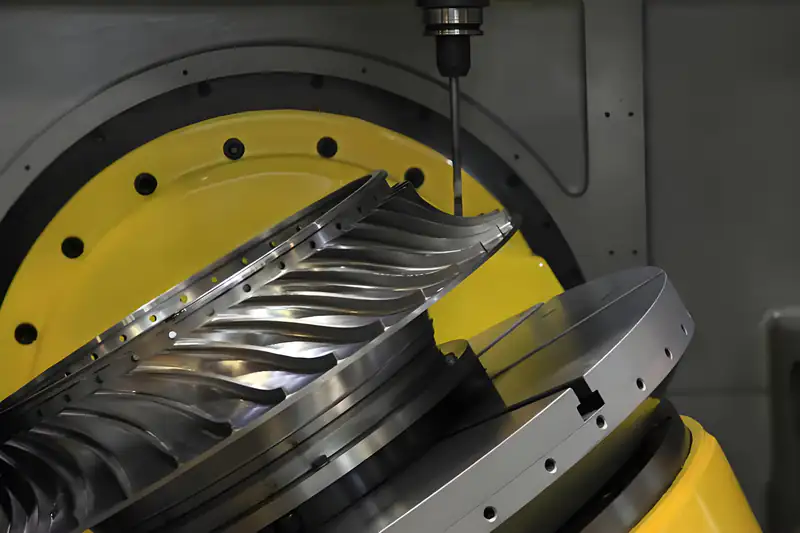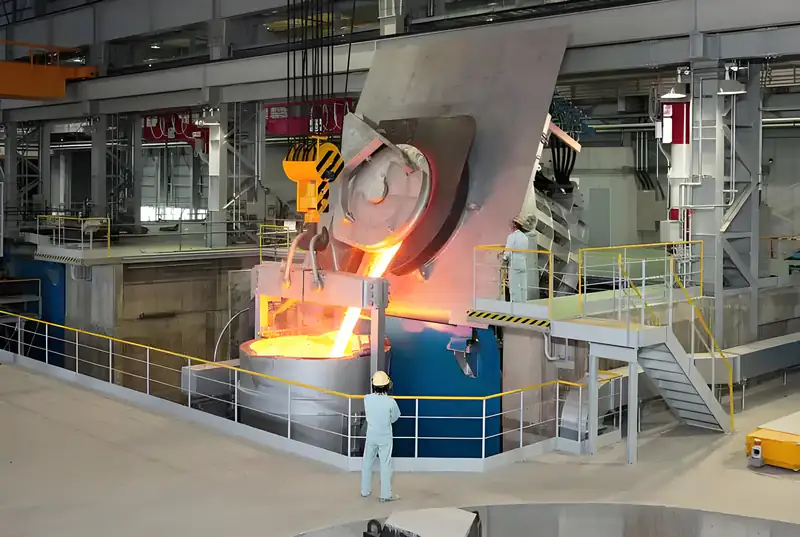Classification of metal manufacturing processes
Date: 2024-08-03 Categories: Blog Views: 1442

Hot working includes casting, forging and welding. Cold working, also known as metal cutting process, including tool cutting process (which has turning process, drilling and boring process, planing, inserting, broaching, milling process, abrasive cutting process; the processing of gear teeth). The following are briefly introduced.
(i) Casting

The process of casting involves pouring liquid metal into a casting mold and leaving it to cool to obtain a casting of a certain shape and character. This is the method of forming metal in the liquid state. Casting can produce billet blanks with complex shapes, especially complex internal cavities, with unlimited size and weight. Both single-piece production, can also be mass production, the use of most of the material from a wide range of sources, low prices, but also available scrap and waste parts, so the cost is low. Castings and parts of the shape and size close to the processing allowance is small. The disadvantage of castings is that there are many processes, process control is difficult. Due to the metal cooling internal stress, easy to defects, so the quality is not stable; due to its internal organization coarse uneven, its mechanical properties are not as high as forgings. There are also problems of high labor intensity and poor labor conditions.
Casting production methods are divided into two categories of sand casting and special casting, sand casting-based.
1,sand casting Most sand molds are still made by hand. Sand casting is mainly used for cast iron, cast steel, cast copper, cast aluminum and other materials casting production. Castings structural design, to consider the casting process and metal making performance requirements, to prevent the production of shrinkage holes, shrinkage loosening, underpouring, cold segregation, deformation and cracks and other defects, should pay attention to the following issues: ① castings should have a reasonable wall thickness and structural slope, casting wall thickness as uniform as possible. ② casting wall connection: casting wall connection should have structural rounded corners. Avoid cross and sharp angle connection, thick wall and thin wall articulation should be a gradual transition. ③ Castings should avoid excessive horizontal plane. ④ In order to prevent the casting from warping and deformation, for the larger flat castings and the long box with uneven wall thickness, it should be designed into a symmetrical shape or increase the ribbed plate to improve its stiffness. ⑤ Avoid the casting shrinkage is hindered such as common wheel-shaped castings, the spokes of the wheel is an even number of linear shape. However, for alloys with large shrinkage, cracks are sometimes produced due to excessive stress. In order to prevent cracks, can be made of curved spokes, in order to take the spokes or rim of the wheel deformation, reduce the internal stress. (6) according to the principle of sequential solidification design casting structure The cast steel shell shown in the figure, will be changed to the right side of the appearance of the shell at the bottom of the 76mm to maintain a uniform wall thickness, and gradually increase the wall thickness until the flange with the flange, to ensure that the shell in accordance with the sequential solidification, no longer produce shrinkage defects.
2,Specialty Casting
- ① Molten mold casting, wax as the material for the mold, also known as "lost wax manufacturing", can cast a variety of non-ferrous and ferrous metal castings.
- ②metal molding The model can be used repeatedly for 40,000 times, the casting has good precision (up to IT12~IT14), the surface is smooth and clean, it can be used with less or no processing, and it can be mechanized.
- (iii)pressure casting : Die casting machine indoor casting liquid or semi-liquid metal, filling Pu type, and under high pressure forming and crystallization. Commonly used die casting pressure of 5 ~ 150MPa, metal flow rate of 5 ~ 100m / s. High efficiency and easy to realize automation, product quality is good, realize less chip and no chip processing, low cost. ④Low-pressure casting .
- ⑤ Centrifugal casting: Liquid metal is added to a rotating casting mold.
(ii) Forging
Including forging and stamping, plastic deformation of metal under the action of external forces, generally at high temperatures. Forging is divided into two categories of free forging and die forging. Stamping processing object is sheet metal, generally at room temperature, so also known as sheet metal stamping or cold stamping.
1、Free exercise
The billet will be placed on the equipment (free forging hammer or hydraulic press) between the top and bottom of the iron, because the billet is free flowing under pressure, so it is called free forging. According to the use of equipment and forging force nature of different, free forging is divided into free forging on the hammer and free forging on the hydraulic press, large forgings to be carried out on the hydraulic press. Free forging products of poor dimensional accuracy, material consumption, low productivity, poor labor conditions, labor intensity, only in a single piece, small batch production is reasonable.
2、Die forging
When die forging, the blank is placed in the forging die chamber, so that the workpiece pressure forming. According to the use of different equipment, die forging is divided into the hammer on the die forging, crank press on the die forging, flat forging machine on the die forging screw press on the die forging and other specialized equipment on the die forging. Die forging productivity is high, the surface of the workpiece is clean, high dimensional accuracy, high material utilization, forging internal, forging flow distribution is more reasonable, improve the service life, can be forged soft complex parts, simple operation, easy to mechanize, low cost, commonly used in small and medium-sized forgings of mass production.
3、Sheet stamping
The sheet metal is processed using a die mounted on a press bed to deform or separate it to obtain a part or blank. Plate blanks are usually thin plates with a thickness of 1~2mm or less generally without heating. The raw materials for sheet metal stamping should have good plasticity and low resistance to deformation, such as low carbon steel, alloy steel, copper, aluminum. Stamped parts are light in weight, good stiffness, light structure, stable quality and good interchangeability. Simple operation, easy to mechanize and automate, and low cost. Due to the high cost of stamping mold production, mass production is reasonable.
4. Other pressure processing methods
Extrusion formation, so that the Department of difficult to put Υ Hydra metal deformation, can make a variety of materials, a variety of shapes of metal workpiece, and high precision, good mechanical properties, can be mechanized automation. Roll forming: such as roll rolling, hot rolling gear, rolling ring. Precision die forging, warp forging, high-speed hammer forging and so on.
(iii) Cutting
Cutting processing is divided into two categories of clamping and machining. Clamping is generally hand-operated, mainly scribing, burring, sawing, filing, scraping, drilling and reaming, tapping and buckling, etc., mechanical assembly and repair also belongs to the scope of clamping. Mechanical processing according to the use of cutting tools, is divided into two categories: one is the use of tools for processing, such as turning, drilling, boring, planing, milling, etc.; the other is to use abrasives for processing; such as grinding, articulated grinding, grinding, ultra-finishing. Machining must have tools, such as turning tools, planing tools, inserting tools, sharp tools, boring tools, etc., grinding with the knife is s wheel.
1、Turning processing
Turning machine tools include general machine tools, vertical lathes, turret lathes, profiling lathes, automatic lathes and various special lathes. Turning can process the surface of the end face, external circle, internal circle, taper, thread, rotary molding surface, rotary groove and knurling, etc., the use of a wide range of machining surface accuracy is good, and easy to ensure that the surface of the parts processed by the positional accuracy of the surface, high production efficiency, low production costs.
2、Drilling and boring processing
① drilling machine processing: commonly used equipment are desktop drilling machine, vertical drilling machine and rocker arm drilling machine, etc., capable of drilling, reaming, reaming, tapping, countersinking and countersinking the convex table. ② boring machine processing: the main equipment is a horizontal boring machine. Boring machine can be drilling, reaming, reaming, grooving, turning circle, turning face and milling plane, of which boring is the main. Because of the boring machine on the precise positioning device, suitable for the box seat, bracket and other shapes of complex large parts hole system for positioning and processing, is the key equipment for machining, other equipment can not be replaced. Boring machine processing range is wide, can obtain high processing accuracy and low roughness, its disadvantage is low productivity.
3. Planing, interpolating and broaching
①Planing is used to process flat surfaces, planers are divided into two types: bullhead planers and dragon planers. Planer can process the plane of the horizontal plane, vertical plane, inclined plane, but also can process the groove (right-angle groove, V-shaped and T-shaped groove, dovetail groove) and straight line forming surface. The main motion of the planing machine is reciprocating linear motion, there are empty leads, and each reciprocation is accompanied by two impacts, limiting the speed of planing, low productivity.
②Insertion can be regarded as a "vertical planer", which is mainly used for machining keyways in holes, square holes, polygonal holes, spline holes, and the external surfaces of certain parts. The equipment used for insertion cutting is an insertion machine.
③The equipment for broaching is a broaching machine. The straight line movement of the broach is the main movement. Broaching no feed movement, the feed is by the amount of each tooth of the knife to achieve the amount of elevation. So broaching can be regarded as a high and low order, more than one planing knife for planing disease broaching is generally used for finishing, and a trip to achieve the accuracy requirements, can be processed broaching plane, semi-circular curved surface and some combination of surfaces. Broach is a shaped tool, broaching once to complete the rough cutting, precision cutting, more accurate and trimming work, is a finishing method, high efficiency. But broach manufacturing complex, high cost, can not process step hole, blind hole and oversized hole, only suitable for processing a specification of the hole or keyway.
4, milling processing together
Milling is realized with the rotation of the milling cutter and <movement, is one of the main methods of plane processing. The equipment has horizontal milling machine, vertical milling machine, gantry milling machine, tool milling machine and all kinds of special milling machine. Milling machine can be processed plane (horizontal, vertical, oblique), groove (right-angle groove, keyway, angle groove, dovetail groove, T-shaped groove, arc groove) and molding surface. It is also capable of hole processing (including drilling, reaming, reaming, boring) and indexing work.
5、Abrasive cutting processing
Abrasives are used to cut with a large number of abrasives distributed on the surface of the grinding wheel. Grinding methods include: external cylindrical grinding, internal cylindrical grinding, surface grinding, and thread grinding. In addition, high-precision and high-efficiency grinding methods include: precision grinding, ultra-precision grinding, mirror grinding, high-speed grinding, wide-wheel grinding, slow-feed deep-cutting grinding, and Jin J grinding wheels with cubic boron nitride wheels. General-purpose grinding machines include ordinary cylindrical grinding machines, universal cylindrical grinding machines, internal grinding machines, surface grinding machines and centerless grinding machines.
6、Light finishing
Finishing refers to grinding, honing, superfinishing and polishing. Grinding: between the workpiece and the research tool coated with abrasive, the workpiece can be driven by the lathe to rotate, the research tool hand-held back and forth axial movement, often testing, until qualified. Grinding fluid from kerosene, vegetable oil or kerosene plus oil. The most commonly used research tool material is cast iron. The amount of grinding is generally 0.005 ~ 0.02mm. Honing: honing head by a number of oil stone strips instead of the research tool, used as a hole in the finishing process. Ultra-finishing: The oil stone strips with very fine abrasive grains are used as the grinding head to be lightly pressed on the working surface for processing. Polishing: The soft wheel coated with polishing paste is rotated at high speed to carry out weak cutting on the work, in order to reduce the roughness of the work surface and improve the brightness.
7、Processing of gear tooth shape
Gears are widely used in many types of mechanical equipment and instrumentation, is an important part of the transmission of movement and power. Commonly used are: straight tooth cylindrical gear drive, helical tooth cylindrical gear drive, spiral tooth cylindrical gear drive, straight tooth bevel gear drive and worm gear transmission. Ensure that the gear transmission mechanism to operate accurately, smooth and reliable, must choose the appropriate tooth profile curve, that is, the tooth curve, the current use of the tooth curve mainly involute, cycloid and arc, etc., the most used is the involute. If a moving straight line in the plane along the radius of rb circle for pure rolling without sliding, then the trajectory of any point on the moving straight line a is called the radius of rb circle of the involute, radius of rb circle is called the base circle, the moving straight line is called the occurrence of the line. Involute gear tooth is formed by the same base circle of two opposite involute composition. Involute; any point a1 normal must be tangent to the base circle, the shape of the involute and the base circle radius size, the smaller the radius, the smaller the curvature of the involute, and vice versa, when the radius of infinity, the involute will become a straight line, the straight line of the rack can be viewed as the radius of infinity of the base circle of the formation of the involute.
(1) Names, basic parameters and main dimensions of each part of straight-toothed cylindrical gears
①Names of Departments Tooth Top Circle--The circle that passes through the top of the teeth of the selector wheel is called the tooth top circle, and the diameter is indicated by da. Root circle--The circle passing through the root of the teeth of the selector wheel is called the root circle, and the diameter is indicated by df. Indexing circle - In standard gears, the circle where the theoretical tooth thickness is equal to the tooth direction is called the indexing circle, and its diameter is expressed by d and radius by r. The indexing circle is located between the toothed top circle and the toothed root circle, and is the basis for calculating the gear size. Indexing circle tooth thickness - indexing circle on the arc length occupied by a gear tooth is called the indexing circle tooth degree, with s said. Indexing Circle Intertooth - the arc length occupied by a wheel groove on the indexing circle is called the indexing circle intertooth, indicated by e. Circumference - the arc length between the corresponding points of two adjacent teeth on the indexing circle is called circumference (indexing circle circumference), expressed as P. P = s + e. Top of tooth height - the radial distance from the top of the tooth circle to the indexing circle is called the top of the tooth height, expressed as ha. Working tooth height - when two gears mesh, the radial distance between the top of the two gears is called the working tooth height, expressed in hw. Radial clearance - two gears mesh, a tooth m the top of the circle and the other gear root circle between the radial distance is called radial clearance, with C said.
② the basic parameters of straight-toothed cylindrical gear △ module = when the number of teeth of the gear is Z, the indexing circle diameter d and circumference P has the following relationship: or At this time, so that , then d = mZ where: m - known as the module, the unit of mm. Design of gears will be m as a basic parameter, so that the calculation, processing and testing of gears is greatly facilitated. The size of M reflects the thickness of the gear teeth, size and carrying capacity. i value m has been standardized, such as 0.1, 0.5, 1, 1.5, 2, 3 ......... design according to the gear strength calculations derived from the modulus value, and then selected according to national standards. △ Pressure angle: The angle between the normal force F and its speed at any point K on the involute tooth line is called the pressure angle k at point K. The determined involute, the base circle radius rb is a fixed value, the pressure angle at multiple points on the involute is different, the farther away from the base circle, the greater its pressure angle. Usually referred to as the pressure angle is the pressure angle of point A on the index circle. Its value has been standardized and is often taken as =20°. The correct meshing conditions for involute gears are that the modulus and pressure angle of the two gears should be equal, respectively, and that the modulus m and pressure angle of the tool must be the same as that of the gear being processed in the toothing process. Once the number of teeth Z and the module m have been determined, the geometry of the gears can be determined in multiple parts, and the formulas are omitted.
(2) Machining of cylindrical gears There are two types of machining methods: molding and grinding. Forming method refers to processing on the milling machine. For straight-toothed cylindrical gears, when m < 8, generally with a disk-shaped modulus milling cutter in the horizontal milling machine. When m≥8, it is carried out on a vertical milling machine. Grinding method is to use the gear cutter and the meshing motion of the gear being cut, cut out the tooth shape on a special machine tool. Commonly used are gear insertion on gear shaping machines and hobbing on gear hobbing machines.
(3) Cylindrical gear finishing Milling, gear insertion and hobbing belong to the shape of the tooth processing, and then have to carry out finishing to further improve the accuracy. Tooth profile finishing methods include shaving, tooth shaping and tooth grinding.
8、Laser cutting
laser cutting It refers to the use of high energy density laser, his diameter as small as possible, focusing to a place to produce high temperature, through the high temperature to melt, vaporize, ablation or reach the ignition point, and at the same time with the help of coaxial with the beam of high-speed airflow blowing off the molten material, so as to achieve the workpiece will be cut. Laser cutting is one of the thermal cutting methods.
(iv) Metal 3d printing technology
cooking oil 3d printing The technology is a cutting-edge metal manufacturing process, which accurately builds complex three-dimensional structures under computer control by accumulating metal powders or wires layer by layer, breaking through the limitations of traditional subtractive and isotopic processing, and greatly expanding the freedom of design and the boundaries of material application.
The main technologies for metal 3D printing include:
- Selective Laser Melting/Sintering (SLM/SLS)
- Electron beam selective melting (EBSM)
- Laser Near-Net Shaping (LENS)
Metal 3D printing technology can be molded directly without the need for molds, which can achieve personalized design and complex structure production, with high efficiency, low consumption, low cost and other advantages.


















